Pelvic organ prolapse has significantly increased in the past five years in the U.S. swine industry, and continues to worsen.
October 15, 2018
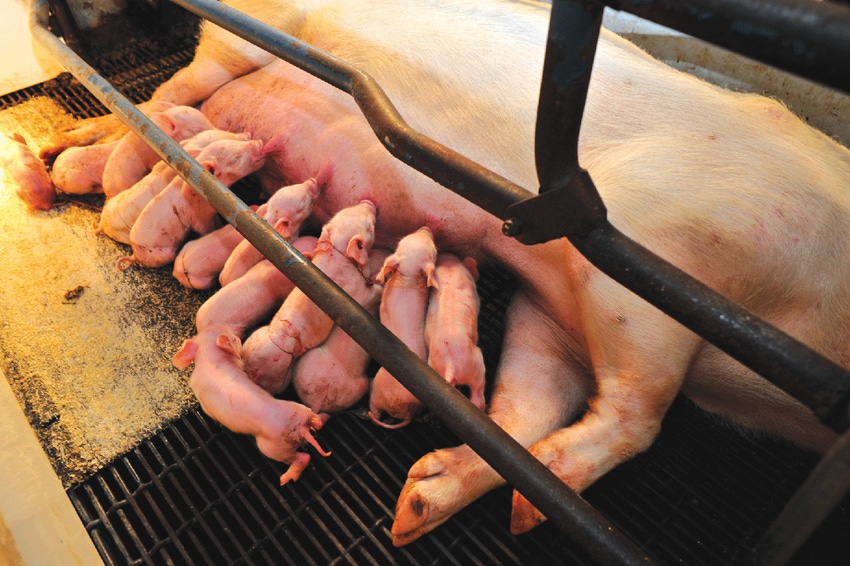
By Amanda Chipman, Chris Rademacher, Daniel Linhares, Gustavo Silva and Jason W. Ross, Iowa State University Iowa Pork Industry Center
Sow mortality, specifically as the result of pelvic organ prolapse (vaginal, uterine and/or rectal), has significantly increased in the past five years in the U.S. swine industry. This epidemic sow welfare and production issue, while widely acknowledged among producers, academia and allied swine industry partners, has persisted and continues to worsen.
However, the industry lacks strategies to reduce the occurrence of prolapses on the farm, or even the ability to execute mitigation-based research projects, since a fundamental understanding of the true root cause(s) contributing to the increased POP is lacking. The Iowa Pork Industry Center at Iowa State University, with funding from the National Pork Board, initiated an industry-wide survey involving U.S. swine breeding herds to identify potential risk factors that will be used to generate hypotheses and test mitigation strategies to prevent POP on sow farms.
Objectives
The long-term objective of our team is to identify potential hypothesized factors for the elevated industry incidence of POP so that mitigation strategies can be developed and employed. IPIC assembled a unique team covering key expertise to accomplish the objective.
The internal team consists of scientists with diverse research expertise in genetics and statistics (Ken Stalder), nutrition (Nick Gabler and John Patience), animal welfare (Anna Johnson and Suzanne Millman), reproductive physiology (Jason Ross) and reproductive toxicology (Aileen Keating), along with veterinarians with extensive swine disease production background (Chris Rademacher), epidemiology and statistics (Daniel Linhares and Gustavo Silva), diagnostic database management (Kent Schwartz) and swine Extension specialists (Amanda Chipman and Colin Johnson).
The central objective of IPIC team on this project was to coordinately work with industry partners to establish a fundamental understanding of potential contributing sow pelvic organ prolapse factors.
Partnerships and strategy
There are 104 commercial sow farms representing approximately 400,000 sows across the U.S. that were enrolled in this project, representing varying POP incidence rates, production systems, geographical locations, genetics and management practices. Eighty-five farms from 13 larger production systems and 19 farms representing independent producers were recruited to participate in the study. The farms range in sow inventory from 600 to 10,000 sows.
Weekly mortality and prolapse data were submitted by farms from January through July 2018 using a standardized code to categorize causes of mortality in a consistent manner across all systems and farms. This information was used to create weekly POP incidence rate per 1,000 sows and annualized POP rates.
The IPIC team developed a comprehensive survey to examine herd level factors such as the farm’s facility type, genetics, health status, nutrition strategies, farrowing management protocols and environmental conditions, among others. On 62 of the 104 farms, IPIC staff conducted site visits to collect individual sow measurements on late-gestating sows including, but not limited to, perineal score, tail length and body condition.
This was an observational study that used descriptive analysis to identify areas requiring further specific hypothesis-driven research. More specifically, this study is enabling the group to determine future work by identifying risk factors associated with POP under field conditions.
The major outcome of this study was defining risk factors associated with the number of weekly POPs per 1,000 sows. Various statistical methods were applied to these data to assess risk factors associated with POP incidence rate.
Initial findings
The annualized POP mortality across the entire data set was 2.7% (of the total inventory), with individual farms ranging from 0.3% to 10.3%. A wide variation in POP mortality among the enrolled farms was critical for the success of the project, as differences observed between high- and low-incidence herds may help the understanding of underlying causes of prolapses.
Figure 1 shows weekly changes in POP presented as the farms for which the average POP rate is in the lowest 20% of all farms (tan line), the 60% of farms considered to have an average POP rate (blue line), and the farms for which the average POP rate is in the highest 20% of all farms (brown line). The average annualized POP rates were 0.9%, 2.4% and 5.7% for the lowest-incidence herds, average-incidence herds and highest-incidence herds, respectively.
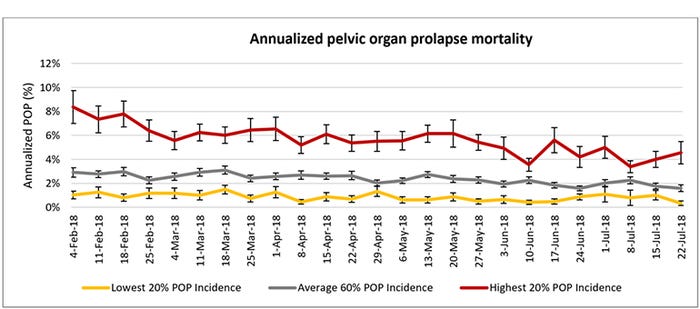
Figure 1: Weekly annualized POP mortality for the 20% of herds with the lowest POP incidence, 60% of herds with the average POP incidence, and 20% of herds with the highest POP incidence from February through July 2018.
Separating the farms into these groups revealed that farms most afflicted by higher annualized mortality as the result of the POP experience greater change over time, and higher annualized mortality is not observed in the farms experiencing lower incidence rate of POP.
The eight standardized categories for causes of mortality for the study were vaginal or uterine prolapse, rectal prolapse, both vaginal and rectal prolapse, difficulty farrowing or retained pig(s), disease, intestinal complication or ulcer, lame or injured or downer, and unknown or other. Of all mortality reported from weeks 6 (Feb. 4) through 30 (July 28), 22% of all mortality was due to pelvic organ prolapses.
The largest category was unknown or other, including 39% of the total mortality with lameness — at 29%, the second-largest category (Figure 2). Long-term, the IPIC team intends to use these data and information to help the industry pursue reductions in overall sow mortality, particularly mortality caused by POP.
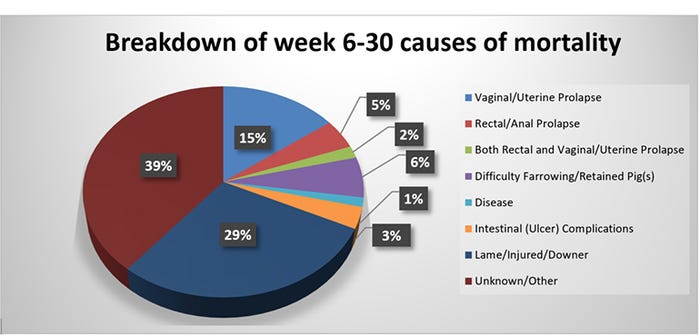
Figure 2: Breakdown of causes of mortality for 104 farms during February through July 2018.
Information was collected on many factors — some of which were chosen to address some factors already assumed, without significant evidence — to be associated with POP incidence. Preliminary analysis demonstrated that some potential root causes not statistically associated with POP incidence were herd size, induction protocols in farrowing, farrowing assistance protocols, and tail length when using P < 0.05 as the threshold of significance.
During farm visits, a total of 4,953 body condition scores were assigned during late gestation using a three-point scale. A total of 884 sows were considered a BCS 1 (thin); 3,378 sows had a BCS 2 (normal body condition); and 691 sows had a BCS 3 (overweight). The average BCS of the farm tended to have a negative relationship with prolapse incidence (R2 = 0.06; P = 0.06), in that farms with the lower average BCS tended to have the higher prolapse incidence.
Analysis
Retrospective analysis after the scored sows underwent opportunity for farrowing indicated that 65 of them prolapsed (1.3% of all animals scored). Figure 3 shows the distribution of BCS for the sows that prolapsed, revealing that a greater percentage of thinner sows actually experienced POP compared to normal condition or overweight sows. Twenty-one (2.4%) of the BCS 1 sows prolapsed, 41 (1.2%) of the BCS 2 sows prolapsed, and three (0.4%) of the BCS 3 sows prolapsed.

Figure 3: Percentage of sows prolapsed according to body condition score during late-gestation.
The observation that sows with the lowest body condition score had a greater probability of POP compared to sows in optimal body condition or overweight is consistent with our observation that feeding strategy prior to farrowing was identified as being important for POP incidence. Use of bump feeding during late gestation reduced (P = 0.02) POP rate in farms bump-feeding animals with a lower body condition score compared to farms not bump-feeding (see Figure 4).

Figure 4: Association of bump feeding strategy in late-gestation on POP incidence. Farms either did not use bump feeding, bump fed all animals or only bump fed those considered to have a low body condition score.
Additionally, a perineal scoring system was developed and used to assess potential for prolapse during late gestation. Individual sows were scored with a three-point perineal score (1, a presumed low risk of prolapse; 2, a presumed moderate risk of prolapse; and 3, a presumed high risk for prolapse) assessing the swelling and protrusion of the vaginal and rectal areas of late-gestating sows.
Figure 5 shows the distribution of perineal scores for the sows that prolapsed after the scored sows underwent opportunity for farrowing. Out of the 2,906 animals scored, 1.1% (14 of 1,310) of sows prolapsed that scored a 1, 0.8% (11 of 1,361) of sows prolapsed that scored a 2, and 7.2% (17 of 235) of sows prolapsed that scored a 3.
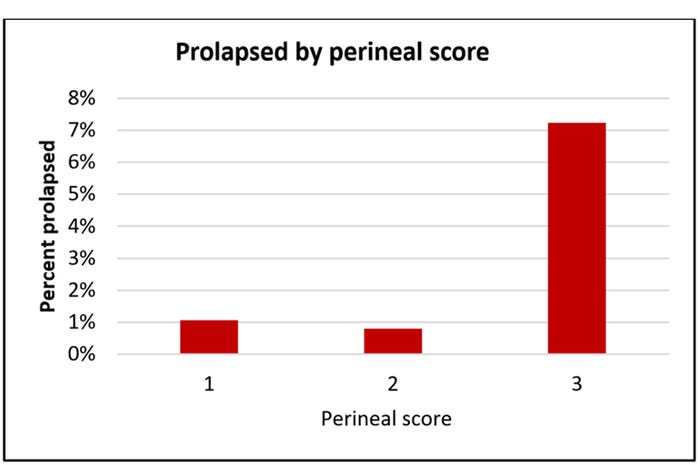
Figure 5: Percentage of sows prolapsed according to perineal scores.
This suggests an increased risk of prolapse for those sows designated as a perineal score 3 just prior to farrowing. The average perineal score of the farm was positively associated to herd-level prolapse incidence in that the higher the average perineal score, the higher the farm’s POP incidence (Figure 6; R2 = 0.18, P < 0.001). This scoring system has potential for further investigations to better assess the biological causes and the effectiveness of POP mitigation strategies.
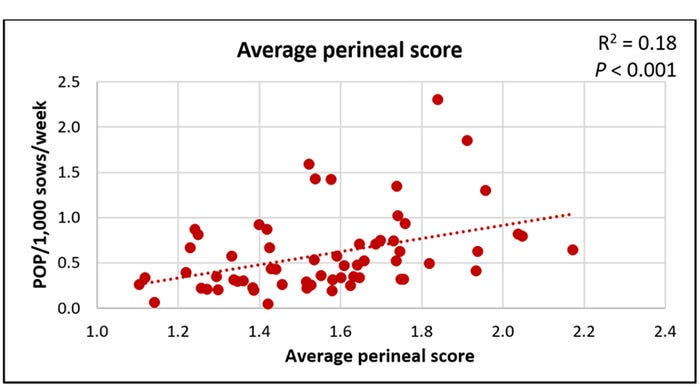
Figure 6: Relationship between herd average perineal score and POP incidence.
Additionally, water treatment appeared to reduce POP incidence, with those farms treating with water (using either a chlorine- or peroxide-based treatment system) having lower POP-induced mortality than those farms that did not (P < 0.0001). When analyzing water sources, farms in this study using water treatment on well or pond water sources had lower POP incidence than those using untreated well water, while rural water was no different in POP incidence from treated or untreated water (Figure 7).
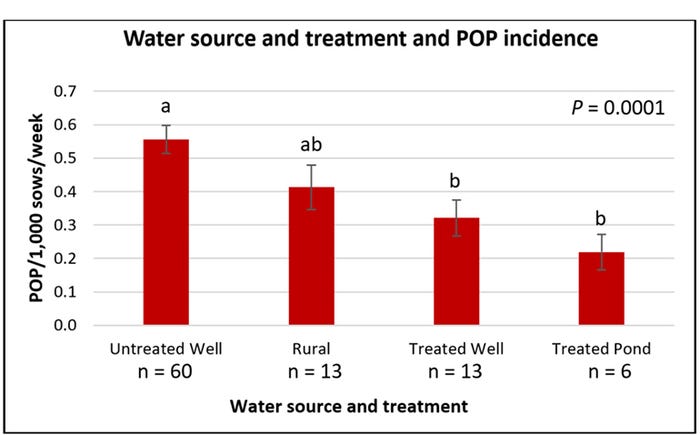
Figure 7: Relationship of water source and treatment on POP incidence.
When analyzing the weekly mortality rates of those farms that treat their water compared to those that do not, mortality due to POP was lower in farms that treat their water for almost every week during the data collection period (Figure 8). It appears that treating the water was associated not only with lower annualized POP mortality but also annualized total mortality. These associations were extremely consistent on a weekly basis.
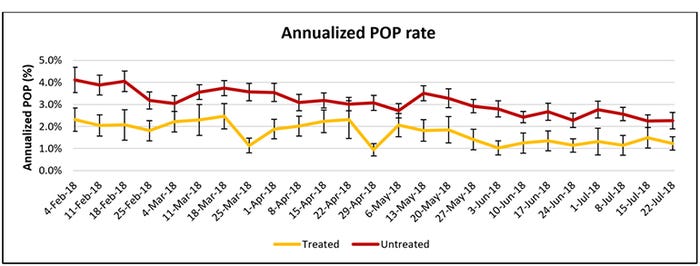
Figure 8: Weekly annualized POP induced mortality rate for farms using treated and untreated water.
Future directions
Results from this study have preliminarily identified several different risk factors needing further investigation to verify their causality for increased POP risk and potential mitigation strategies. Collection of mortality data from these farms is still ongoing and, therefore, POP incidence could change over time.
Additional evaluation will be completed to further define and prioritize risk factors likely contributing to a greater incidence in POP in the farms evaluated in this study. These results represent a portion of our analysis as we continue to evaluate additional data and factors (i.e., disease status, nutrition, diet formulations, mycotoxin exposure).
Due to the nature and scope of the study, the recruitment of farms was based partially on historical prolapse incidence to include a wide variation of POP incidence among farms; therefore, the farms were not balanced for management system, genetics, sow housing or other management factors. The limited number of participating herds for some variables will warrant further investigation.
Additionally, the perineal scoring system has potential for further investigations to better understand the biological causes of POP and the effectiveness of mitigation strategies employed to reduce POP. It can be used to gain a larger pool of individual sows for biological samples, since prolapse incidence — while a significant issue in the industry — still has a relatively low incidence rate to measure statistical differences during shorter-term controlled studies.
Further, this project supports the concept of building an ongoing collaboration from commercial farms from multiple production systems across the U.S. swine industry for field research, allowing within- and between-production system comparisons.
This project was funded by the National Pork Board project No. 17-224 and supported by a vast network of industry collaborators representing producers from 15 states managing about 400,000 sows. The team is grateful to all the swine producers who participated in the study.
You May Also Like



